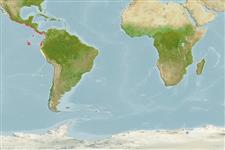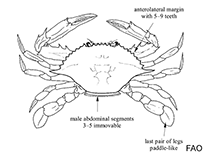Callinectes toxotes Ordway, 1863
Giant swimcrab| Native range | All suitable habitat | Point map | Year 2050 |

|
| This map was computer-generated and has not yet been reviewed. |
| Callinectes toxotes AquaMaps Data sources: GBIF OBIS |
Google image | No image available for this species;
drawing shows typical species in Portunidae.
Classification / Names Common names | Synonyms | CoL | ITIS | WoRMS
Malacostraca | Decapoda | Portunidae
Environment: milieu / climate zone / depth range / distribution range Ecology
Benthic; depth range 0 - 77 m (Ref. 112850), usually ? - 30 m (Ref. 112850). Tropical; 18°C - 34°C (Ref. 112850); 24°N - 34°S, 112°W - 77°W
Distribution Countries | FAO areas | Ecosystems | Occurrences | Introductions
Eastern Pacific: From Cape San Lucas, Baja California and Sinaloa (Río Piaxtla), Mexico to mouth of river Tumbes, Peru and Juan Fernandez Island, Chile.
Length at first maturity / Size / Weight / Age
Maturity: Lm ? range ? - ? cm Max length : 16.0 cm CW male/unsexed; (Ref. 121685)
Life cycle and mating behavior Maturity | Reproduction | Spawning | Eggs | Fecundity | Larvae
Main reference
References | Coordinator | Collaborators
Taylor, M.H., M. Wolff, F. Vadas and C. Yamashiro. 2008. (Ref. 92517)
IUCN Red List Status
(Ref. 130435: Version 2024-2)
CITES status (Ref. 108899)
CMS (Ref. 116361)
Threat to humans
Human uses
Fisheries: commercial
| FishSource |
Tools
More information
Max. ages / sizes
Length-weight rel.
Length-length rel.
Length-frequencies
Mass conversion
Abundance
Internet sources
BHL | BOLD Systems | CISTI | DiscoverLife | FAO(Publication : search) | Fishipedia | GenBank (genome, nucleotide) | GloBI | Gomexsi | Google Books | Google Scholar | Google | PubMed | Tree of Life | Wikipedia (Go, Search) | Zoological Record



